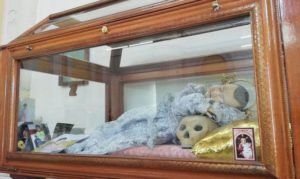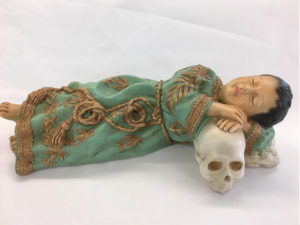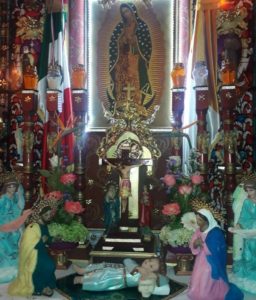Podcast: Play in new window | Download
Subscribe: Apple Podcasts | RSS
 The year was 1806. Two young priests were walking on a remote back road in a wooded area of what would later be the Distrito Federal or Federal District of the independent nation of Mexico. The place then was part of New Spain and the monster that is now Mexico City was a long way from this remote country road. Headed to the small town of Santiago Tepalcatlalpan the two young priests heard the cries of a young boy. They were surprised because they had not seen anyone on the road in hours and the area around them was wilderness. Concerned, they began to search the surroundings. When they approached the place where the crying came from, they encountered a small carved wooden image of the Baby Jesus who was sleeping peacefully on a skull. As they got closer to this serene image, water started bubbling up out of the ground. Today, this very spot is known as “El Ojo del Niño,” or “Eye of the Child,” in English. The location around the spring would later become the site of the seminary of the Salesian Fathers. After the seminary was abandoned, the Mexican government built a tuberculosis sanitarium there. The groundwater has since been diverted and the greater Mexico City metropolitan area has grown, so now the place of the miraculous appearance of the Baby Jesus resting peacefully on a skull is part of the Niño Jesús neighborhood of the suburb of Tlalpan. What ever became of the curious statue?
The year was 1806. Two young priests were walking on a remote back road in a wooded area of what would later be the Distrito Federal or Federal District of the independent nation of Mexico. The place then was part of New Spain and the monster that is now Mexico City was a long way from this remote country road. Headed to the small town of Santiago Tepalcatlalpan the two young priests heard the cries of a young boy. They were surprised because they had not seen anyone on the road in hours and the area around them was wilderness. Concerned, they began to search the surroundings. When they approached the place where the crying came from, they encountered a small carved wooden image of the Baby Jesus who was sleeping peacefully on a skull. As they got closer to this serene image, water started bubbling up out of the ground. Today, this very spot is known as “El Ojo del Niño,” or “Eye of the Child,” in English. The location around the spring would later become the site of the seminary of the Salesian Fathers. After the seminary was abandoned, the Mexican government built a tuberculosis sanitarium there. The groundwater has since been diverted and the greater Mexico City metropolitan area has grown, so now the place of the miraculous appearance of the Baby Jesus resting peacefully on a skull is part of the Niño Jesús neighborhood of the suburb of Tlalpan. What ever became of the curious statue?
The two young priests gathered up the holy carving and brought it to Mexico City. There, they presented it to the Archbishop of Mexico, the very powerful Francisco Javier de Lizana y Beaumont who would later serve as the 58th Viceroy of New Spain. The archbishop was taken by the statue and proclaimed it a divine sign of the mercy of God. He wanted to find a special place for it so that it could be properly venerated. After consulting his council, Archbishop Lizana decided to hold a raffle to determine which religious community, church or shrine would be responsible for housing this unique artistic representation of the Baby Jesus. When the lots were drawn, the winner was the Convent of San Bernardo, run by mostly European-born Conceptionist nuns. The convent was in a state of disrepair and the nuns lived an austere, meager existence. The Archbishop of Mexico did not think this was an appropriate choice, so he ordered the raffle be taken again. In the second round, the Convent of San Bernardo was chosen again. So, the name of the convent was taken out of the contest altogether. During the third drawing, the name of the Convent of San Bernardo came up a third time, and seeing this as a sign from God, the archbishop relented and gave the statue to the nuns. The sisters of San Bernardo saw this as a gift from Heaven. The attention the statue would bring to their order would have many beneficial and long-lasting effects. Because of their good fortune in this raffle, the Mother Superior of the convent christened this holy carving “El Santo Niño de las Suertes” or “The Holy Child of Luck.” Two hundred years later, it is still known as the Santo Niño de las Suertes and this unusual representation of the Baby Jesus has attracted millions of pilgrims from throughout Mexico and beyond.
 The sculpture is polychrome on wood, created in the late 1700s or early 1800s and probably handcrafted in Europe. It is an image of a child of approximately four months of age, with a white complexion, eyes closed, lying on his side. Both his head and his arms rest on a skull that serves as a pillow. The baby and the skull imagery may be a curious mix to the uninitiated or to people not familiar with what this might mean. Some may see this as creepy or even bordering on the occult. Father José de Jesús Aguilar, a scholar and devotee to this holy image said this about the Santo Niño de las Suertes:
The sculpture is polychrome on wood, created in the late 1700s or early 1800s and probably handcrafted in Europe. It is an image of a child of approximately four months of age, with a white complexion, eyes closed, lying on his side. Both his head and his arms rest on a skull that serves as a pillow. The baby and the skull imagery may be a curious mix to the uninitiated or to people not familiar with what this might mean. Some may see this as creepy or even bordering on the occult. Father José de Jesús Aguilar, a scholar and devotee to this holy image said this about the Santo Niño de las Suertes:
“It represents the sleeping (Christ) child lying on a human skull. It is a symbolic image that represents Christ’s dominion over death. During the Baroque period, images of the Baby Jesus were created in which his passion, death and resurrection could be foreshadowed. Thus, we can see images of the Child Jesus with the cross or crucified, or with a thorn in his foot or in his hand and even with a crown of thorns on his head. The image of the Santo Niño de las Suertes would represent Christ sleeping, alluding to his rest in the tomb after his passion, a rest that would end with the resurrection and triumph over death.”
In an interview with Antropología, the journal associated with the Mexican National Institute of Anthropology and History, a mother superior of the San Bernardo Convent further clarified the meaning of the imagery of this interesting Santo Niño. She stated:
 “In the New Testament death is mentioned as one of the greatest evils, and it will be the last enemy that Christ subdues on the day of his second advent. Although Jesus died for our sins, at the end of time, when the resurrection is extended to all, the triumph over death will have been achieved. This sculpture illustrates the end of death promised by the birth of a baby. It also causes great admiration how, in such a tiny, inoffensive being, such greatness develops for human beings. The skull represents humanity; it is a redemption for us.”
“In the New Testament death is mentioned as one of the greatest evils, and it will be the last enemy that Christ subdues on the day of his second advent. Although Jesus died for our sins, at the end of time, when the resurrection is extended to all, the triumph over death will have been achieved. This sculpture illustrates the end of death promised by the birth of a baby. It also causes great admiration how, in such a tiny, inoffensive being, such greatness develops for human beings. The skull represents humanity; it is a redemption for us.”
The nuns set up a small chapel dedicated to the Santo Niño de las Suertes that has changed little over time. Devotees can sit in rows of pews to contemplate the image or to pray, with the holy statue encased behind glass at the part of the chapel where the altar would be. A long, thin, neon bulb hanging from two wires illuminates the Santo Niño. His backdrop is made of a soft satin cloth covered in rows of milagros, the tiny metal charms given as tokens of thanks for miracles received. For more information on milagros, please see Mexico Unexplained Episode Number One https://mexicounexplained.com/the-magic-of-milagros/. The baby is dressed in delicate clothing which is changed throughout the course of the year in accordance with the Catholic calendar.
As is typical of many such shrines in Mexico, devotees have ascribed many miracles to the Santo Niño de las Suertes. Traditionally, he is seen as being responsible for interceding in matters of work, health, and even love. As the image represents the Christ Child, anything connected with children or pregnancy is within his realm as well. Because the word “luck” is associated with this statue, in modern times people have visited the shrine to help with gambling addictions or even for luck in winning games of chance or even the lottery, but the church frowns on those sorts of devotions. People have claimed that the Baby Jesus represented here has appeared to them incarnate, as a living, breathing being, whether it be at the edge of a hospital bed or in the desert alongside a struggling migrant crossing over to the United States. Some construction workers building the new convent have also claimed to have seen this Baby Jesus appear at the construction site. Those who frequent the chapel or who have made various pilgrimages to see the Santo Niño, claim that his complexion changes color from pale white to bright pink depending on his mood. When asked about the statue’s changing colors, one of the nuns remarked, “perhaps it is because he is sad for humanity.” As with other shrines in Mexico, devotees leave behind toys, candles, ex voto paintings, handwritten letters and other assorted objects as offerings to the Baby Jesus. The area near the statue is cleaned of these objects periodically with toys donated to charity and devotional objects and other items of meaning carefully stored away.
 In recent years, the Santo Niño de las Suertes has been confused with, mixed with or paired up with Mexico’s most popular folk saint, the Santa Muerte. The Santa Muerte is not recognized by the Catholic Church and is the personification of death itself in the form of an image very reminiscent of the Western European concept of the Grim Reaper. For more information about the Santa Muerte, please see Mexico Unexplained episode number 9 https://mexicounexplained.com/the-santa-muerte-death-respected/. Possibly because of the skull imagery of this unique Santo Niño, there has been a growing connection to this famous underground folk saint of death. The nuns taking care of the Santo Niño de las Suertes chapel noticed this connection in the early 2000s, which was coincident with the meteoric rise in the popularity of the Santa Muerte throughout Mexico. February 2 on the Catholic calendar is Candlemas, or in Spanish, “Candelaria,” often called The Feast of the Presentation, when Mary and Joseph brought the Baby Jesus to the Temple in Jerusalem 40 days after his birth. In many parts of Mexico on February 2 people who have household Baby Jesus statues clean them, dress them up and take them to a church for a special Candlemas blessing. On Candlemas each year the nuns at the Santo Niño de las Suertes chapel started noticing people bringing in their Baby Jesus statues dressed as the Santa Muerte in a black or red hooded garment accompanied sometimes with a scythe and a skull. Some have also been bringing into the Santo Niño chapel candles and small statues of the Santa Muerte, much to the disappointment of the nuns. The current Abbess has a policy that anyone presenting Santa Muerte imagery of any kind be asked about their devotion to the folk saint and where they stand regarding traditional Catholicism. In a recent interview, the abbess explained that many worshipping the Santa Muerte are unaware that the Santo Niño de las Suertes has no connection to this folk saint of death and when confronted by the nuns the visitor usually withdraws their items with Santa Muerte imagery. This connection between the powerful folk saint of death and this unique Santo Niño cannot be controlled by the nuns in this convent, however. In shrines to the Santa Muerte throughout Mexico, icons and statues of the “Lucky Baby Jesus” are starting to appear with more frequency. As with everything, perhaps this Santo Niño is evolving and taking on new meaning as it leaves the bounds of traditional Catholicism. The future of this unique holy image may take on a life of its own and develop into something quite unexpected. Only time will tell.
In recent years, the Santo Niño de las Suertes has been confused with, mixed with or paired up with Mexico’s most popular folk saint, the Santa Muerte. The Santa Muerte is not recognized by the Catholic Church and is the personification of death itself in the form of an image very reminiscent of the Western European concept of the Grim Reaper. For more information about the Santa Muerte, please see Mexico Unexplained episode number 9 https://mexicounexplained.com/the-santa-muerte-death-respected/. Possibly because of the skull imagery of this unique Santo Niño, there has been a growing connection to this famous underground folk saint of death. The nuns taking care of the Santo Niño de las Suertes chapel noticed this connection in the early 2000s, which was coincident with the meteoric rise in the popularity of the Santa Muerte throughout Mexico. February 2 on the Catholic calendar is Candlemas, or in Spanish, “Candelaria,” often called The Feast of the Presentation, when Mary and Joseph brought the Baby Jesus to the Temple in Jerusalem 40 days after his birth. In many parts of Mexico on February 2 people who have household Baby Jesus statues clean them, dress them up and take them to a church for a special Candlemas blessing. On Candlemas each year the nuns at the Santo Niño de las Suertes chapel started noticing people bringing in their Baby Jesus statues dressed as the Santa Muerte in a black or red hooded garment accompanied sometimes with a scythe and a skull. Some have also been bringing into the Santo Niño chapel candles and small statues of the Santa Muerte, much to the disappointment of the nuns. The current Abbess has a policy that anyone presenting Santa Muerte imagery of any kind be asked about their devotion to the folk saint and where they stand regarding traditional Catholicism. In a recent interview, the abbess explained that many worshipping the Santa Muerte are unaware that the Santo Niño de las Suertes has no connection to this folk saint of death and when confronted by the nuns the visitor usually withdraws their items with Santa Muerte imagery. This connection between the powerful folk saint of death and this unique Santo Niño cannot be controlled by the nuns in this convent, however. In shrines to the Santa Muerte throughout Mexico, icons and statues of the “Lucky Baby Jesus” are starting to appear with more frequency. As with everything, perhaps this Santo Niño is evolving and taking on new meaning as it leaves the bounds of traditional Catholicism. The future of this unique holy image may take on a life of its own and develop into something quite unexpected. Only time will tell.
REFERENCES
“El Color de la Fe” website, article on the Santo Niño (in Spanish): https://elcolordelafe.com/2019/01/13/el-santo-nino-de-las-suertes/
Perdigon Castaneda, Judith Katia. “Una relacion simbiotica entre La Santa Muerte y El Santo Nino de las Suertes.” In, LaminaR, vol. 6, no. 1, June 2008 (in Spanish)
